
When an Ariane 5 rocket lifted off from French Guiana on Christmas Day 2021, it carried a cargo of dreams: the James Webb Space Telescope (JWST). Those dreams belonged to astronomers hoping to peer farther into space than ever before, to a time when the first galaxies formed; to penetrate dust clouds to witness the birth of stars; and to probe the atmospheres of exoplanets to see if they might support life. After more than a year in space, JWST is starting to turn those dreams into reality.
The newest space telescope comes with significant advantages over any previous mission. First and foremost is its size: JWST features a 6.5-meter mirror composed of 18 gold-plated hexagonal segments. This colossus gathers more than six times as much light as the Hubble Space Telescope’s 2.4-meter mirror, so it can record light from objects six times faster than its predecessor.
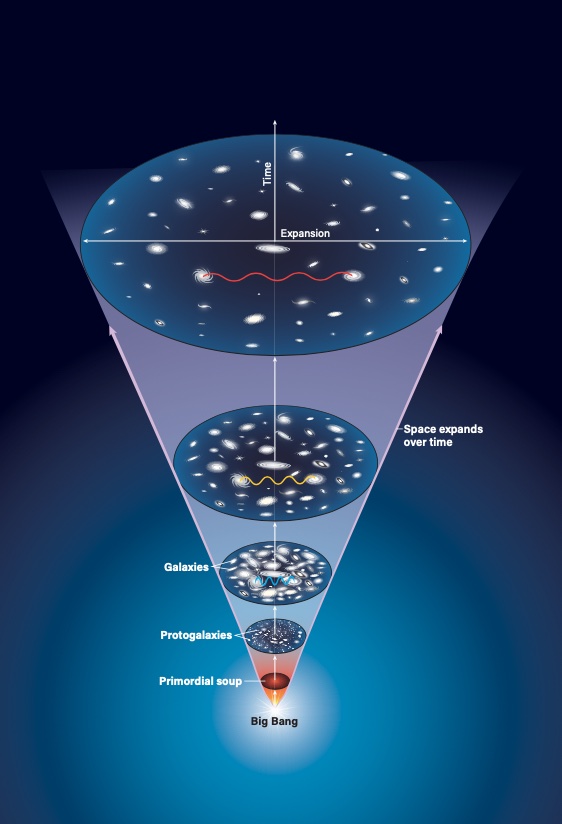
But JWST’s sensitivity to infrared light is the real game-changer. The space telescope can view wavelengths from 0.6 to 28.5 micrometers, from the red end of the visible spectrum to the mid-infrared. Hubble’s optics are optimized to record radiation from 0.09 micrometer (in the ultraviolet) to 2.5 micrometers (in the near-infrared), with the majority of its sensitivity centered on visible light. Perhaps surprisingly, in its intended infrared domain, JWST generally won’t resolve finer details than Hubble achieves in optical light: Although resolution increases with mirror size, it also diminishes with wavelength.
Observing in the infrared allows astronomers to see galaxies that existed less than a billion years after the Big Bang. These distant objects emit ultraviolet and visible light, but the expansion of the universe shifts this radiation to longer infrared wavelengths. Peering into the infrared is the only way to observe these young galaxies from Earth’s vicinity. The same holds true for newly forming stars. The dust that envelops infant suns scatters visible light, hiding what lies within from our eyes, but it lets infrared radiation largely pass through.
Humans cannot see infrared radiation. So, the colors in JWST images don’t match what the eye would see. In many cases, scientists map longer infrared wavelengths to the red end of the visible spectrum and shorter wavelengths toward the blue, mimicking how the eye operates. But sometimes this pattern is altered to show details in a more revealing light.
Although JWST launched in late 2021, it took the space observatory 29 days to reach its home orbiting the L2 Lagrange point about 930,000 miles (1.5 million kilometers) from Earth, and an additional five months for scientists and engineers to get the telescope ready for its debut. Most of the results so far come from early-release science programs and proposals from the first cycle of science operations (Cycle 1). Read on to explore some of the telescope’s most exciting early finds.
Close to home
Despite its focus on distant galaxies and star formation, JWST is an all-purpose observatory. Its powerful infrared eye sees details in solar system objects beyond the reach of conventional telescopes. Early observations include studying cloud belts on the gas and ice giant planets; tracking cloud formations on Saturn’s largest moon, Titan; exploring Pluto’s climate; and probing many of the smaller asteroids and trans-Neptunian objects that populate the outer solar system.
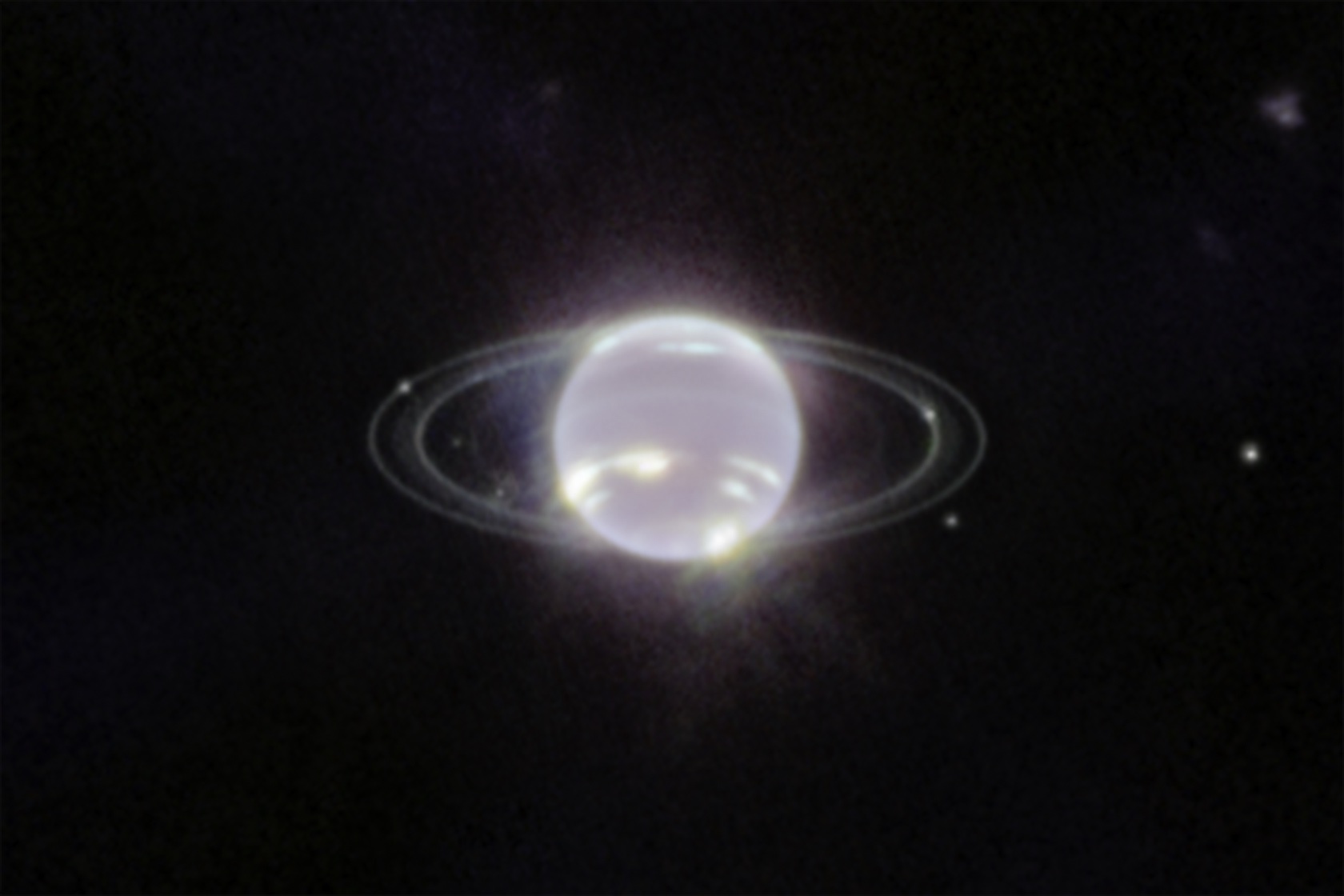
JWST even observed the asteroid moonlet Dimorphos in September when NASA’s Double Asteroid Redirection Test (DART) slammed into it. The impact slightly changed the object’s orbit around its parent body, Didymos, helping the space agency assess its ability to alter the course of potentially hazardous asteroids that could cross Earth’s path.
It’s not far-fetched to think of the space telescope as a planetary weather satellite for the entire solar system. Our last close-up views of Saturn came just before the Cassini spacecraft crashed into the ringed planet in September 2017. And no spacecraft has visited Uranus or Neptune since Voyager 2 flew past them in the latter half of the 1980s. But JWST can view storm systems on these worlds in exquisite detail.
Neptune came under the telescope’s watchful eye last July. Most of the ice giant’s visible surface looks dark because methane gas in its atmosphere absorbs near-infrared light. But several clouds of methane ice gleam brightly and a hint of the planet’s global circulation appears as a thin line tracing the equator. This circulation powers Neptune’s storms and powerful winds, which blow faster than those of any other planet. JWST also delivered the sharpest views of Neptune’s rings since Voyager 2 visited the world in 1989.
Other Worlds
Even as planetary scientists work to reveal our solar system’s many tantalizing secrets, the over 5,000 known exoplanets in our galaxy remain a mystery. While we typically know their orbits and often their sizes and masses, most other information lies beyond the reach of Earth-based telescopes and even Hubble. But JWST has already started to change the status quo.
How important are exoplanets to JWST scientists? They allocated nearly one-quarter of observing time during Cycle 1 to the study of these worlds and the materials that form them.
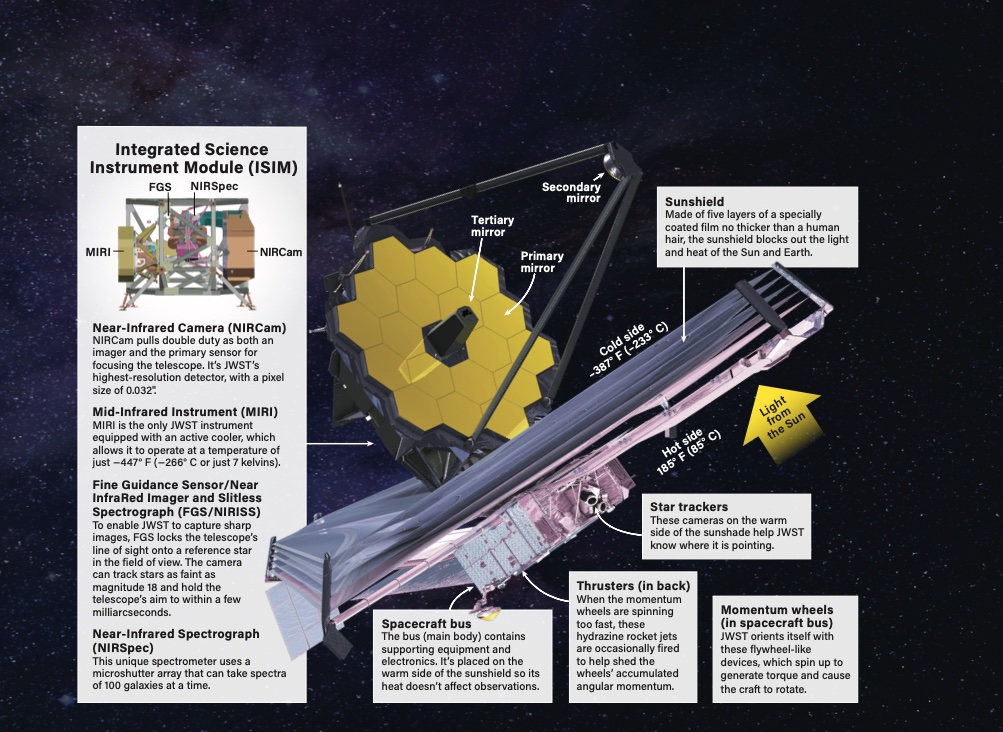
Although not designed to discover exoplanets, JWST has confirmed one around the star LHS 475, a red dwarf located 41 light-years from Earth in the constellation Octans. NASA’s Transiting Exoplanet Survey Satellite (TESS) hinted that this star might harbor a planet, but it took the new space telescope to confirm the minuscule dip in brightness caused by the planet crossing in front of, or transiting, the star’s disk. The planet appears to be rocky, with a diameter just 1 percent smaller than Earth, though the resemblance to our home world stops there. It orbits its sun in only two days and boasts a temperature a few hundred degrees warmer than Earth.
However, JWST’s real strength comes from its ability to analyze the atmospheres of exoplanets. To accomplish this, the telescope must observe transits with its powerful spectrographs. As a planet passes between Earth and its host star, its atmosphere filters out some wavelengths of the starlight. Because every atom and molecule has a distinct spectral fingerprint, this allows astronomers to study the chemical makeup of these worlds.
Most of the molecules that interest exoplanet researchers lie in the infrared part of the spectrum. While Hubble could tease scientists with its observations, JWST will satisfy their appetites.
The observatory’s first exoplanet target was WASP-39 b, a hot gas giant planet orbiting a Sun-like star 700 light-years away in the constellation Virgo. JWST’s superb resolution revealed water, sulfur dioxide, carbon monoxide, sodium, potassium, and — for the first time ever in any exoplanet — carbon dioxide. The planet glows at a temperature of 1,650 degrees Fahrenheit (900 degrees Celsius) not because of a runaway greenhouse effect, but because it orbits just 4.52 million miles (7.27 million km) from its star. (In comparison, Mercury orbits nearly 36 million miles [57.9 million km] from the Sun.)
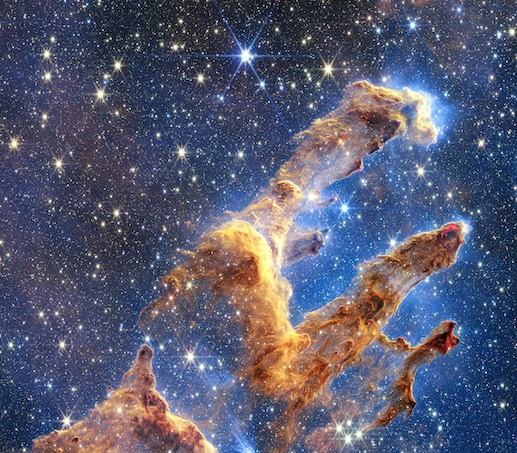
Peering Inside Stellar Nurseries
Planets and their host stars all form inside the gas- and dust-rich stellar incubators astronomers call nebulae. But these clouds — as beautiful as they may be — cloak the vital activities happening within, at least in visible light. JWST’s infrared vision has started to open up these environments.
One of its first targets was a small portion of the Eagle Nebula (M16) in the constellation Serpens, which Hubble made famous in 1995. The dramatic “Pillars of Creation” image was ranked among TIME magazine’s list of the 100 most influential photos of all time. JWST captured an equally stunning view of this iconic star-forming region, which resides 6,500 light-years from Earth.
Where Hubble saw mostly opaque dust and cold gas, JWST revealed many stars already emerging from their natal cocoons. Most of these newborn stars appear outside the dark pillars and reveal themselves by their diffraction spikes, a feature of images taken with reflecting telescopes like JWST.
These infant suns have had time to ignite nuclear fusion in their core and become full-fledged stars. But JWST uncovered even younger objects known as protostars still pulling gas and dust from their surroundings. Such youngsters periodically spew jets of material that collide with their dense surroundings and cause them to radiate. The best examples show up as bright red glows near the tips of the two lower pillars. Astronomers estimate the protostars are just a few hundred thousand years old.

Beyond the Milky Way
Star formation occurs throughout the universe, of course, and JWST scientists have been keen to explore its many expressions outside our galaxy. Two key sites lie within our Local Group. The Large and Small Magellanic Clouds, the two most massive satellite galaxies of the Milky Way, play a huge role in deciphering the universe.
That’s because the amount of metals — elements heavier than helium cooked up within massive stars — in the two galaxies turns out to be about half that in the Milky Way. These conditions mimic those that existed when the cosmos was just 2 billion or 3 billion years old and galaxies were churning out stars at their highest rate. The fireworks during this so-called cosmic noon shaped the galaxies at that time and continue to influence the galaxies we see today.
No feature in the Magellanic Clouds comes closer to mirroring these chaotic times than the large cloud’s Tarantula Nebula (NGC 2070). (For more on the Tarantula Nebula, see “Untangling the Tarantula Nebula” in the September 2021 issue.) The largest star-forming region in the local universe, the Tarantula forges new stars at a ferocious pace. Astronomers have cataloged some 820,000 stars to date, and the vast reservoirs of hydrogen and helium the nebula contains should be good for hundreds of thousands more. The brilliant star cluster at its center, dubbed R136, holds dozens of stars that weigh at least 100 solar masses.
JWST’s initial observations reveal the Tarantula in unprecedented detail. Fierce radiation and stellar winds from the massive stars in R136 have cleared out a large bubble in the nebula’s central region. Only the densest surrounding areas, likely harboring baby stars of their own, resist this onslaught. Because the nebula lies only 160,000 light-years from Earth — a mere stone’s throw on a cosmic scale — the Tarantula gives astronomers a close-up view of conditions they’ll encounter as they explore the cosmic noon in more depth.
To The Edge
In many cases, observations of close objects allow researchers to make better sense of more distant ones. Planets in our solar system inform studies of exoworlds just as star formation in the Magellanic Clouds sheds light on similar regions in the distant universe. In much the same way, studying interacting galaxies leads directly to the ultimate goal of understanding the turbulent early days of the cosmos.
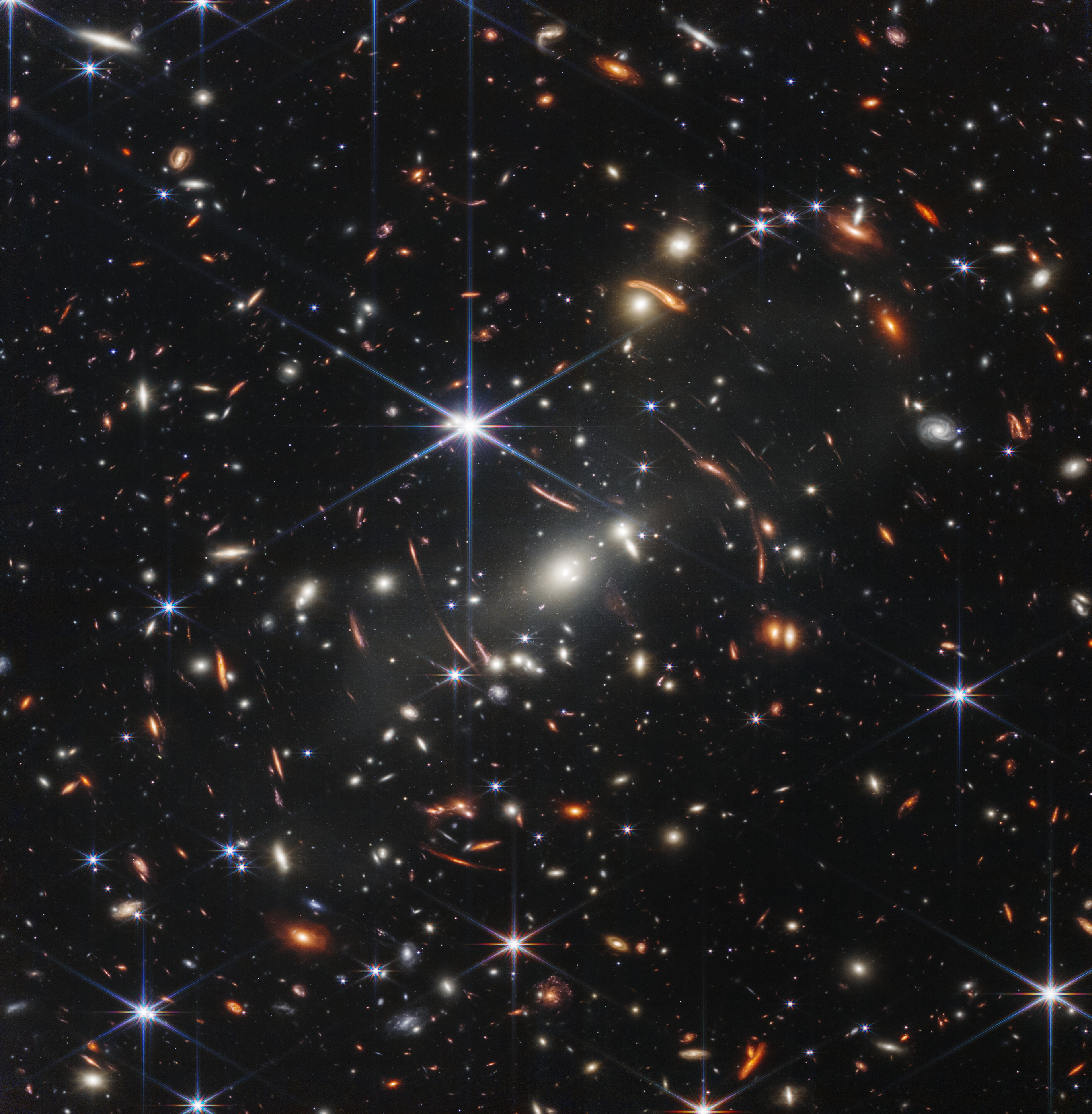
But while nearby regions can often serve as analogues for older, more distant environments, JWST was designed to directly observe ancient galaxies formed at the dawn of the cosmos — and astronomers have relished testing this capability.
One of JWST’s first images — and the first one publicly released — was a deep-field photo of the galaxy cluster SMACS 0723 in the southern constellation Volans. The exposure took 12.5 hours, compared with weeks for Hubble’s various deep fields, and records galaxies even fainter and farther that Hubble could see.
We see SMACS 0723 as it appeared “only” 4.6 billion years ago. But thanks to the cluster’s huge mass, which acts as a gravitational lens to magnify and distort objects behind it, we can see galaxies that existed within a billion years of the Big Bang. As you might expect, the tiniest galaxies in the field lie farthest away. Intriguingly, they don’t look anything like the more mature spiral and elliptical galaxies closer to Earth.
But perhaps the most significant discoveries so far are the two most remote galaxies ever seen. Using the massive galaxy cluster Abell 2744 in Sculptor as a gravitational lens, scientists uncovered two island universes that existed just 450 million and 350 million years after the Big Bang (which occurred 13.8 billion years ago). The galaxies appear exceptionally bright and likely would have started assembling only 100 million years after the Big Bang. Researchers don’t yet know if the galaxies hold lots of dim stars or a few extraordinarily bright Population III stars — hypothetical massive stars consisted solely of hydrogen and helium that were the first stars to grace the cosmos.
JWST’s ride on that Ariane 5 rocket went so smoothly that NASA now estimates the observatory has enough fuel to operate for at least 20 years. That means the science, discoveries, and beautiful images have only just begun.









